The Ultimate Guide for Collecting Testimonials from Clients

Testify team
March 13, 2023

Did you know that customer testimonials can significantly boost your business's credibility and sales? In today's competitive market, having a solid collection of authentic and convincing testimonials can make all the difference.
In this ultimate guide, we will cover everything you need to know about testimonials for your business, including the benefits of testimonials, strategies for collecting testimonials from clients, and how to make the most of collected testimonials for sales and marketing.
The Power of Customer Testimonials

Customer testimonials serve as valuable social proof, showcasing your business's presence and the quality of your products or services. By featuring testimonials on your website, you can increase trustworthiness and boost sales and conversions.
But why gather these powerful testimonials ? Let's dive deeper into the impact of social proof and the importance of authentic customer testimonials.
Social Proof and Trustworthiness
You know how at a dinner party, you're more likely to trust a friend's recommendation for the best cheesecake than a commercial on TV? It's the same when it comes to businesses! We're wired to value the 'been-there-done-that' voice of existing customers over a flashy ad. In fact, like cherry-picking dessert options, 19% of individuals say they must check out online reviews before buying anything new.
And for a solid 38%, reading reviews is as crucial as getting the right amount of sugar in their tea. By letting your happy clients do the talking on your website with their authentic client testimonials, you're serving up just the right kind of sweet and trustworthy social proof that can sway potential customers.
Boosting Sales and Conversions
Featuring testimonials on your website enables you to control the narrative and have a direct impact on sales and conversions. For example, incorporating a testimonials page into a website has been shown to yield an increase in conversions of 34%.
Dedicating a space for testimonials does more than simply satisfying a visitor's curiosity. It's like holding an open house where you can strategically decorate with the most flattering testimonials. By doing so, you are subtly guiding potential customers towards the check-out button. This curated showcase of client praises can act as a powerful sales catalyst, directly enhancing your conversions and pushing your revenue upwards.
Strategies for Collecting Testimonials
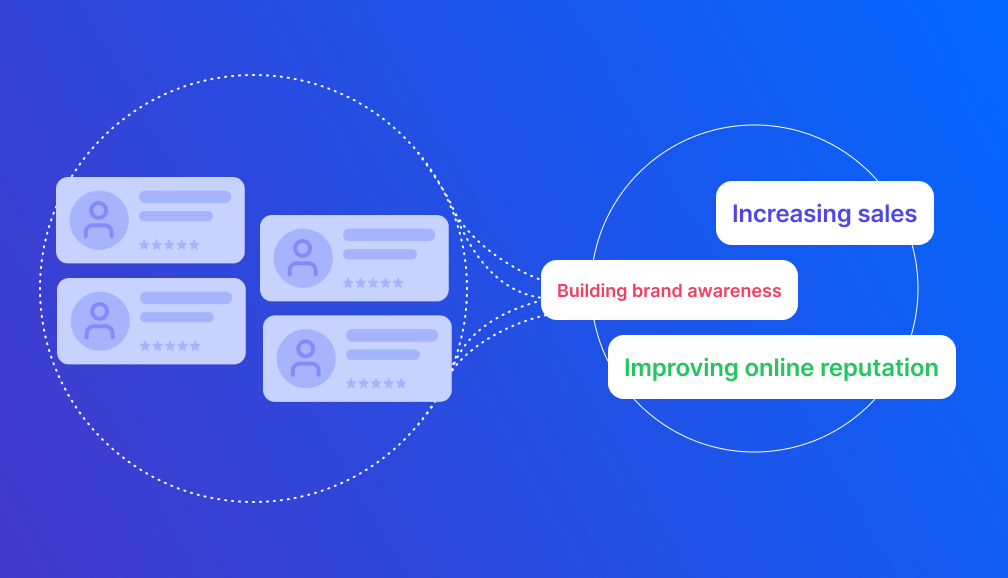
Now that we understand the power of customer testimonials, we can explore creating an effective strategy for testimonial collection. There are 4 main steps of an effective strategy listed below:
- Identify your goals for testimonials
- Choose your outreach method
- Create a Testimonial collection system
- Collect testimonials
1. Identify your goals for testimonials
The first step in planning your testimonial collection process is to identify your goals. What do you want to achieve with your testimonials? Do you want to increase sales, build brand awareness, or simply improve your online reputation? Once you have clear goals in mind, you can tailor your approach to the type of feedback you're looking for.
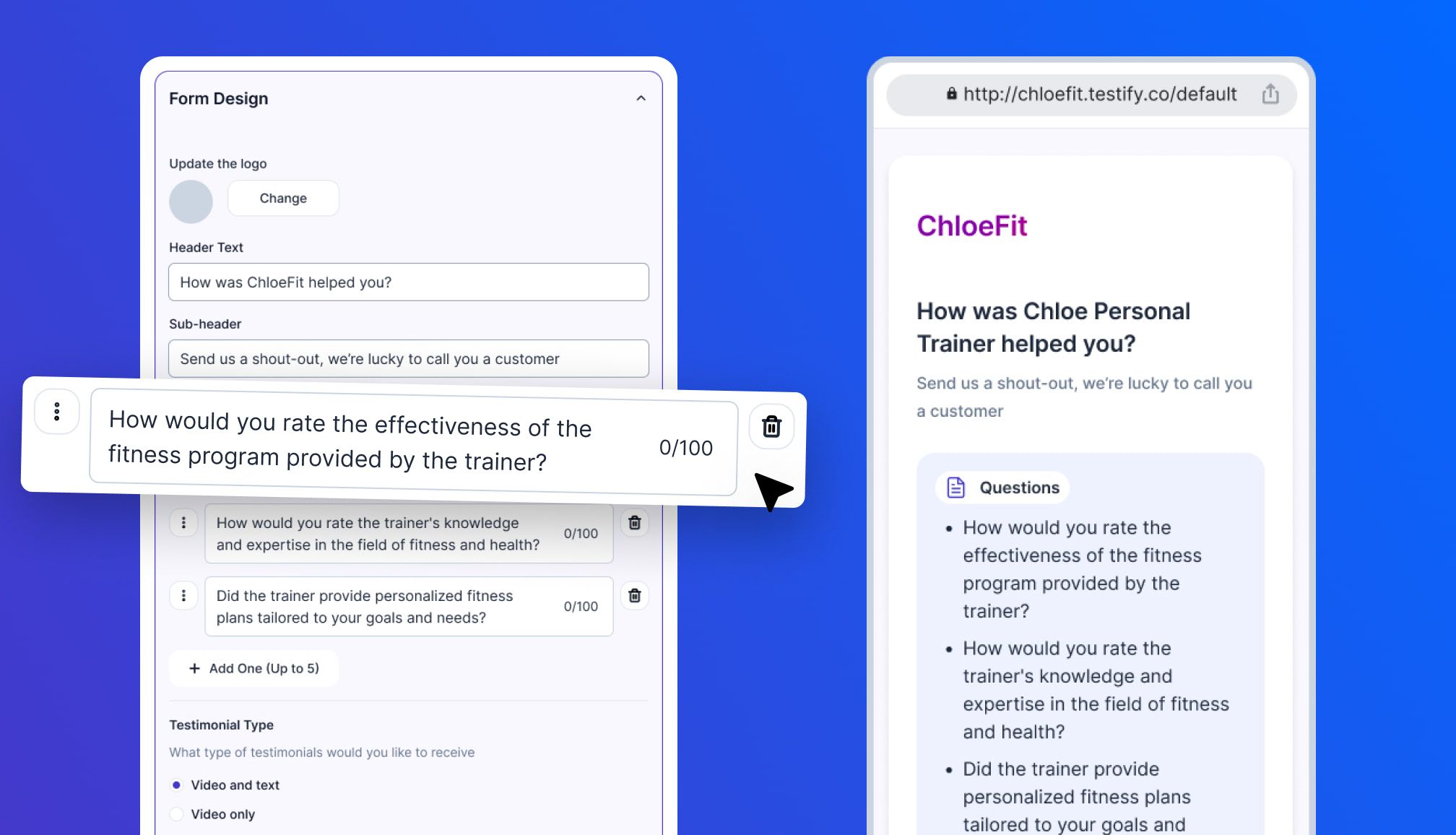
For example, if your goal is to increase sales, you may want to focus on collecting testimonials that highlight the benefits of your product or service. On the other hand, if your goal is to improve your online reputation, you may want to focus on collecting testimonials that speak to the overall quality of your business.
Setting the goal is important because it helps inform on the testimonial questions to ask your clients.
2. Choose your outreach method(s)
There are three main strategies for requesting testimonials: directly asking clients, utilizing social media, and offering incentives.
Directly Asking Clients
Directly asking clients for testimonials is the most effective approach. To ensure success, it is crucial to ask the right questions and make the process easy for your clients. By using a sample testimonial request email or a testimonial request form, you can streamline the testimonial request process and increase the likelihood of receiving positive client testimonials.
Additionally, timing is essential – it's recommended to request a testimonial from a client at the conclusion of your work together or immediately following a successful resolution.
Utilising Social Media
Social media platforms such as Twitter, Instagram, and Facebook can be leveraged to collect testimonials from your customers. By engaging with your customers and asking for testimonials through direct messages or posts, you can reach a wider audience and gather more testimonials.
Additionally, social media channels can help you showcase your existing customer testimonials, further strengthening your online presence and increasing the visibility of your business.
Offering Incentives
Think of incentives like a cherry on top, a little reward that encourages your customers to pen their testimonials. It could be a discount on their next purchase or even a gift card. However it's not all about collecting praises; it's about being honest too. Remember to disclose that these testimonials came with a small 'thank you' from your end.
With a mix of rewards and crystal clear transparency, you can collect glowing reviews and build a bridge of trust with your potential customers.
3. Create a Testimonial Collection System
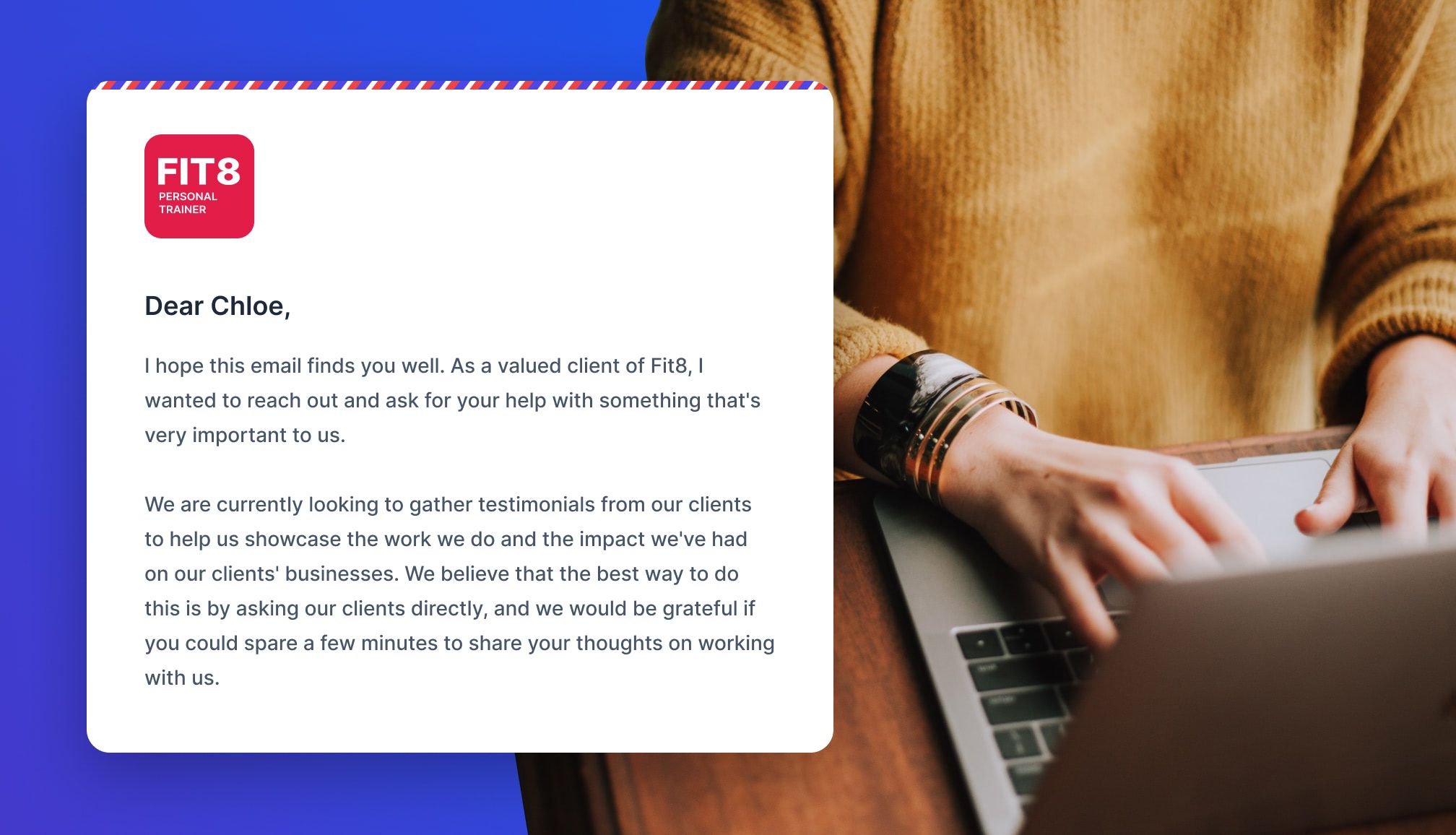
Your testimonial collection system should run like a well oiled machine. Crafting a persuasive testimonial request email, designing an easy-to-fill form, and setting up an automated process for requests are your secret ingredients for a seamless testimonial collection routine.
DRAFTING a Persuasive Testimonial Request Email
Creating a compelling testimonial request email isn't about weaving magic with words, it's about empathy, timing, and a clear call-to-action. When asking customers to take time out of their day to help your business, it's essential to consider their perspective. Consider the following tips:
- Timing is Everything: Ideally, you should send a testimonial request email soon after a positive interaction or successful transaction with the customer. This is when their experience is still fresh in their mind, and they are more likely to have a positive sentiment towards your business.
- Make It Personal: Use the customer's name and any relevant details about their purchase or interaction. Personalization shows the customer that you value them individually and that the email isn't a generic mass message.
- State Your Intent Clearly: The purpose of your email should be clear from the get-go. Tell them you'd love for them to share their thoughts and experiences about your product or service.
- Keep It Simple and Short: Don't overwhelm your customers with a lengthy email. Keep it concise and respectful of their time.
- A Gentle Nudge to Action: Make sure you have a clear call-to-action. This could be a link to click, a form to fill out, or a reply to the email. Make it as easy and straightforward as possible for them to provide their testimonial.
- Be thankful: A little gratitude goes a long way. Be sure to thank your customers for their time and let them know how much their input matters to you.
Crafting an effective testimonial request email is a balance of art and science. By keeping these points in mind, you'll not only garner more testimonials but also build a stronger, more personal connection with your customers.
DESIGNING an Effective Testimonial Form
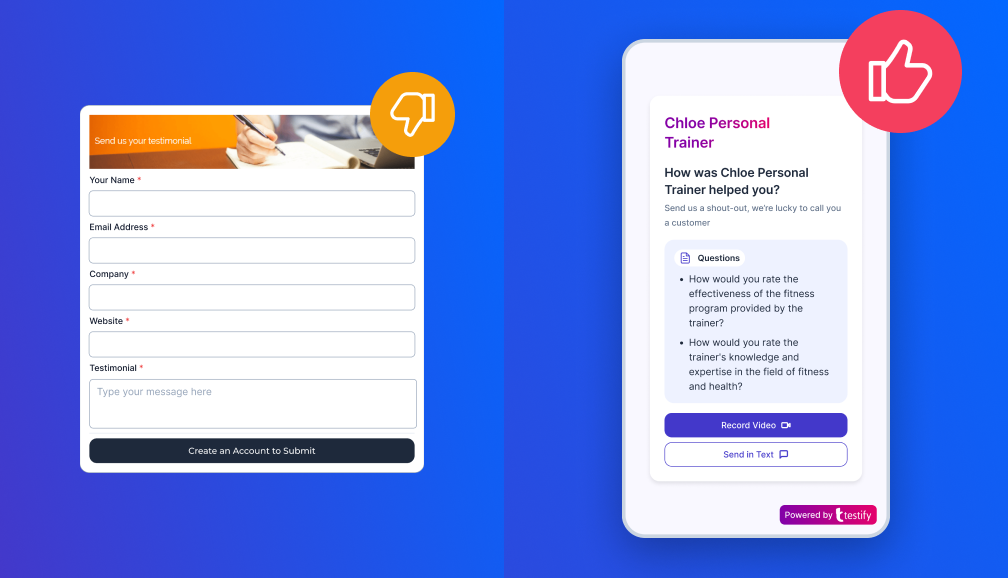
Just as a well-crafted email can set the stage for a flood of testimonials, an intuitive customer testimonial form can make the process a breeze for your customers. Here are some tips for designing a testimonial form that simplifies the process and encourages responses.
- Keep it Short and Sweet: Respect your customer's time. Include only essential fields to increase the chance of a complete response. Overwhelming customers with too many questions can deter them from filling out the form.
- Guide Their Responses: Providing a few prompts can help guide your customers' testimonials. Questions like, "What problem did our product solve for you?" or "How was our service different from others you've tried?" can elicit detailed and persuasive responses.
- Open-Ended Questions Are Your Friends: These questions allow customers to express their thoughts freely and provide detailed responses. A good example could be, "How has our product impacted your daily routine?"
- Include a Ratings Section: This provides a quick and visual way for customers to express their satisfaction. It can also be a valuable piece of quantitative data.
- Ensure it's User-Friendly: The form should be easy to navigate and fill out. If it's online, ensure it's mobile-friendly too. A frustrating experience might dissuade a customer from completing the testimonial.
- Privacy is Paramount: Make sure your customers know their information is safe with you. Include a note, or better yet, a link to your privacy policy to reassure customers their details won't be misused.
- A Clear Call to Action: Make sure the next step is clear, whether it's a 'submit' button or instructions on where to email the completed form.
Designing a testimonial form is about creating a comfortable space for your customers to express their thoughts and experiences. When your customers feel valued and respected, they're more likely to share their stories, leading to powerful testimonials for your business.
Putting Testimonial Requests on Autopilot
Putting your testimonial requests on autopilot isn't just a time-saver, it's a game-changer. Imagine having your testimonial requests flying out like clockwork - no manual work, no reminders. By harnessing the power of automated email templates and text messages, you can do just that. This means less time sending requests, more time collecting the rewards.
But there's another advantage, a subtle yet significant one. Automation helps your brand sing the same tune throughout the testimonial collection process, keeping your messaging harmonious and true to your brand identity.
Making the Most of Collected Testimonials
Once you have collected testimonials from clients, it's important to make the most of them by showcasing them on your website and using them in your marketing materials.
In the following sections, we will discuss how to effectively showcase your testimonials on your website and incorporate them into various marketing materials to maximize their impact.
Display Testimonials on Your Website
Displaying testimonials on your website isn't just about sprinkling positive reviews here and there. Its about fitting them smoothly into your content, adding a layer of trust and authenticity that blends with the page's message. Here are a few tips:
- Feature testimonials on your homepage or landing page: Place testimonials front and centre on your website so that visitors can see them right away. This can help establish credibility with new visitors and encourage them to stay on your site longer.
- Create a dedicated testimonial page: A beautiful testimonial page will showcase all the positive experiences and praises clients have shared in one place. Be sure to check out examples of beautiful testimonial pages for inspiration to make your testimonials as impactful as possible.
- Use visuals: Including images or videos of your clients alongside their testimonials can make them more relatable and engaging. It also helps potential clients to picture themselves using your product or service.
- Group testimonials by category: If you offer different types of products or services, consider grouping testimonials by category to make it easier for visitors to find testimonials that are relevant to their interests.
Use Testimonials on social media
Social media platforms are a great way to get your testimonials in front of a wider audience. By sharing testimonials on social media, you can leverage the power of word-of-mouth marketing and encourage others to try your product or service. Here are some tips for sharing testimonials on social media:

- Use visuals: Just like on your website, including images or videos can make your testimonials more engaging and shareable.
- Tag clients: When sharing testimonials on social media, be sure to tag the clients who provided them. This not only gives them credit but also helps to promote their businesses or personal brands.
- Use hashtags: Using relevant hashtags can help your testimonials reach a larger audience. Consider using hashtags that relate to your industry or target audience.
Use Testimonials in Marketing Material
Testimonials aren't just for your website. They're versatile and can jazz up a variety of marketing avenues – think sales pages, emails, social media posts, blogs, print flyers, presentations, and even YouTube channels. By sprinkling these nuggets of customer praise into your marketing mix, you're not just showing off how good your products or services are - you're also building trust with potential customers.
But remember - keeping it real is key. Make sure your testimonials are genuine and specific to carry the most weight.
Use Testimonials in Your Sales Pitch
Testimonials can be a powerful tool to include in your sales pitch. By using them effectively, you can provide social proof that your product or service is worth buying. Here are some tips for using testimonials in your sales pitch:
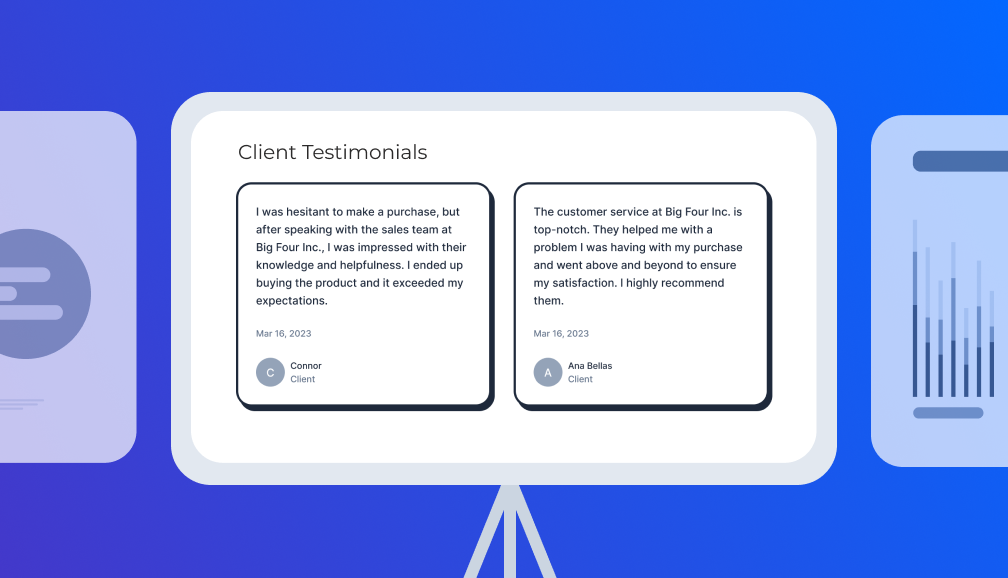
- Choose the right testimonials: When deciding which testimonials to include in your sales pitch, choose ones that are relevant to the specific audience you are targeting. For example, if you are pitching to a healthcare company, choose testimonials that highlight the benefits of your product or service in that industry.
- Use visuals: Including images or videos of your clients alongside their testimonials can make them more impactful.
- Use testimonials throughout the sales process: Don't just save your testimonials for the end of your sales pitch. Incorporate them throughout the entire process to build trust and credibility with your potential clients.
Measure the Impact of Testimonials
Finally, it's important to measure the impact of your testimonials to see how they are contributing to your overall marketing efforts. Here are some ways to measure the impact of your testimonials:

- Track website analytics: Use website analytics tools to track how many people are viewing your testimonials and how long they are staying on your website.
- Monitor social media engagement: Keep an eye on how many likes, shares, and comments your testimonials are receiving on social media.
- Survey customers: Ask your customers how they heard about your business and whether testimonials played a role in their decision to buy.
By tracking and analyzing the impact of your testimonials, you can continually improve and refine your marketing strategy to better serve your clients and attract new ones.
Overcoming Common Challenges in Testimonial Collection

Collecting testimonials isn't always a walk in the park. You may stumble upon a few bumps along the way, like confronting less-than-glowing feedback and verifying authenticity
But fear not! In the upcoming sections, we'll tackle these hurdles head-on and guide you towards a smooth, winning testimonial collection journey.
Dealing with Negative Feedback
Negative feedback isn't a brick wall - it's a door to improvement. When you respond swiftly and professionally, showing understanding and owning up to any issues, you highlight your unwavering commitment to making things right and delivering stellar customer service.
Offering solutions custom-made for each customer's specific needs and addressing their concerns effectively can transform a negative encounter into a positive turn-around. The bonus? More loyal customers, and positive customer testimonials to boost your reputation.
Ensuring Authenticity
Keeping your testimonials as authentic as grandma's secret recipe is vital. This involves confirming the identity of your customer and making sure their testimonial is as genuine as a four-leaf clover. It's also key to keep their feedback untouched - no editing or tweaking.
By sticking to these guidelines, you ensure your testimonials wear the badge of credibility, fostering trust with potential customers.
Customer testimonials are a powerful tool for building trust and credibility, which can ultimately lead to increased sales and conversions. By implementing effective strategies for collecting testimonials and making the most of your collected testimonials, you can significantly enhance your online presence and attract new customers. So don't wait any longer – start collecting testimonials today and watch your business flourish.